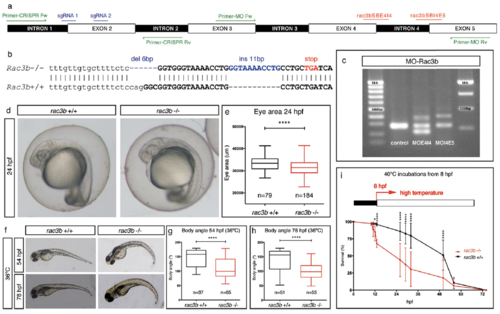
rac3b loss-of-function strategies. (A) Scheme depicting the structure of the zebrafish rac3b transcript showing the following: the position of the two different intron 4 splice-blocking morpholinos (in red) with the corresponding primers to assess the efficiency of the MOs (Primer-MO Fw/Rv; in green), the position of sgRNAs designed for CRISPR-Cas9 gene edition (sgRNA1/2; in blue), and the position of the screening primers (Primer-CRISPR Fw/Rv; in green). (B) Sequence showing mutations induced in rac3b by CRISPR-Cas9 genome edition (rac3b−/−). Generated indels (in blue) produce a premature stop codon (in red) that disrupts the reading frame. Intron 1 is shown in lowercase and exon 2 in uppercase. (C) Agarose gel showing the aberrant splicing products induced by morpholinos as detected by RT-PCR from embryos injected with MO-Control, MO-rac3bSBE4I4, or MO-rac3bSBI4E5. MO-rac3bSBE4I4 generated inclusion of intron 4 (+113) and skipping of exon 4 (−63); MO-rac3bSBI4E5 resulted in the retention of intron 4 (+113). Both MOs reduced the relative amount of WT transcript compared with the control. (D) WT (rac3b+/+) and CRISPR-rac3b homozygous mutant (rac3b−/−) embryos at 24 hpf. At this stage, mutants show a normal appearance with a diminished eye area quantified in E. (E) Box plot showing eye area at 24 hpf of rac3b+/+ and rac3b−/− embryos from three independent clutches (unpaired t test, ****P < 0.0001). (F) rac3b−/− embryos incubated at 36 °C (from 8 hpf onward) display curled body axis at 54 hpf (G) and 78 hpf (H), compared with rac3b+/+ embryos. (G and H) Box plot representation of body angle measurements of rac3b+/+ and rac3b−/− larvae at different stages: 54 hpf (unpaired t test, ****P < 0.0001) and 78 hpf (unpaired t test, ****P < 0.0001). (I) rac3b−/− embryos incubated at higher temperatures (40 °C) display increased lethality rate compared with rac3b+/+ (two-way ANOVA, *P < 0.05 and ****P < 0.0001). For rac3b+/+, n = 720 embryos from four independent clutches; for rac3b−/−, n = 1,080 embryos from six independent clutches. All of the experiments were performed using stable lines.
|

